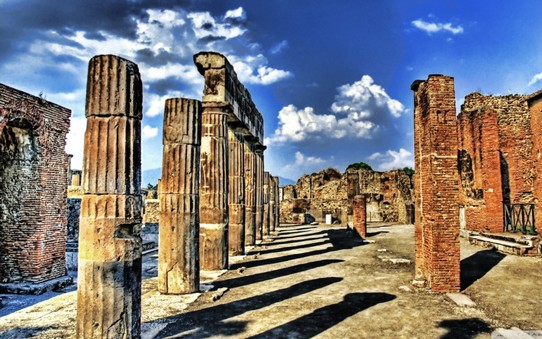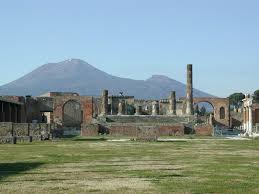Pompei

Pompeii is an Italian municipality of 25.671 inhabitants [2] of the province of Naples in Campania.
Pompeii, in Latin Pompeii and Neapolitan Pumpeie has ancient origins as those of Rome: a migration of inhabitants from the Valle del Sarno, descended from the legendary Pelasgi, formed a primitive settlement at the foot of Vesuvius: perhaps not a real village, more likely a small agglomeration placed at the intersection of three important roads, traced in historical times by the roads coming from Cuma, Nola, Stabia and from Nocera.
A forced passage between north and south, Pompeii became prey for the powerful neighboring states. It was conquered for the first time by the colony of Cuma between 525 and 474 BC. Strabone reports that Pompeii was united to the dodecapoli (the set of the twelve most important Etruscan cities) under the control of Nuvkrinum, news that in the light of recent excavations becomes increasingly reliable. In the area of the temple of Apollo and at the Stabian Baths, numerous fragments of bucchero have been found, some with nacerine inscriptions in graphite; also in the area of the Baths, moreover, a necropolis of the VI century BC has come to light.

The first traces of an important center date back to the sixth century BC, even if in this period the city, still quite small, still seems a rather disorganized and spontaneous aggregation of buildings.
The battle lost by the Etruscans in the waters in front of Cuma against Cumani and Siracusani (mid-5th century BC) brought Pompei under the hegemony of the Samnites. The city joined the Lega nucerina, a confederation that included Nuceria Alfaterna, Ercolano, Stabia and Sorrento, and used the alphabet Native to that which was based on the Greek and the Etruscan. Probably dates back to this period the fortification of the entire plateau with a circle of walls of tufa that enclosed over sixty hectares, even if the city itself did not reach the ten hectares of extension.
He was hostile to the Romans during the Samnite wars. Once defeated, he became an ally of Rome as a member of the City, retaining linguistic and institutional autonomy. It is of the IV century a.C. the first regular urban planning of the city which, around 300 BC, was equipped with a new limestone fortification in Sarno.
During the Second Punic War Pompeii, still under the control of Nuceria Alfaterna, remained loyal to Rome as opposed to Capua and many other cities in Campania, and thus could retain a partial independence.
In the 2nd century BC the intensive cultivation of the earth and the consequent massive export of oil and wine brought wealth and a high standard of living: it would suffice to remember the value of some buildings and their luxurious furnishings. The Casa del Fauno, for example, can rival in amplitude (almost 3000 m²) even with the most famous Hellenistic royal residences.
At the outbreak of the social war (91 BC) Pompeii was hostile to Rome, but it was impossible to resist his military strength: in 89 a.C. Silla, after having capitulated Stabia, left for Pompeii, who tried a strenuous defense reinforcing the city walls and making use of the help of a group of Celts led by Lucio Cluenzio. Every attempt at resistance proved vain and soon the city fell but, thanks to its membership in the Neapolitan League, it obtained Roman citizenship and was included in the Gens Menenia.

In 80 BC he finally entered the orbit of Rome and Silla moved a group of veterans to the Venerea Colony Pompeianorum Sillana. The assignment of land to the veterans occurred at the expense of the gentes who had more bitterly opposed Sulla. Nonetheless, the political and military events did not have a decisive influence on the wellbeing and commercial enterprise of the Pompeii, aimed above all on the export of Campania wines that affected areas also very remote. Due to the salubrity of the climate and the amenity of the landscape, the city and its surroundings also constituted a pleasant holiday resort for some rich Romans, and even Cicero had its own fund.
The sources are quite informative about the life of Pompeii in the early imperial age. Only Tacitus recalls the fight between Nucerini and Pompeiani of 59 AD. in the amphitheater of Pompeii, which encouraged the consuls to forbid all forms of gladiatorial performances for ten years.
On February 5, 62 d. C. the city was then hit by a strong earthquake.
Eruption of 79 d.C.
For further information, see Eruption of Vesuvius of 79.
In the summer of 79 d.C. (first year of reign of Emperor Titus, see Cassio Dione V) Pompeii was submerged by a shower of ash and lapilli (and not washed, as is often reported) that, except for an interval of a few hours, fell uninterrupted to form a layer of over three meters. At the time of the eruption, many buildings were being rebuilt due to an earthquake that occurred a few days earlier, and not for the one in 62 - as previously believed -, whose damage had already been completely repaired.
Plaster cast of one of the corpses found during the excavations
The date of this eruption is known to us on the basis of a letter from Pliny the Younger and should correspond to August 24th. However, not all scholars agree, also because the original does not exist in this letter, but there are only successive transcriptions. In some we talk about the ninth day before the calends of November, corresponding to the 24th of October. Other clues come from the discovery of dried fruit, such as walnuts and figs, or sorbets, typical autumn fruit, but perhaps the most important proof is the discovery of a silver coin bearing the word IMPXV, or the fifteenth acclamation of Tito to emperor, which took place on 8 September 79 AD Cavities were found in solidified ash; these, filled with castings of chalk or other material, then formed the casts of the victims of the eruption.
Pompeii after the eruption
Sanctuary of the Blessed Virgin of the Rosary
Some Byzantine finds testify to the existence of a small settlement even in the Middle Ages; in this period the inhabitants were concentrated in locality Cività Giuliana, north of the ancient city and in a higher position, given the presence of marshes and a strong humidity in the southern part near the river Sarno, the bearer of diseases and death. Subsequently the Sarno was diverted from the Prince of Scafati, and this caused the death of almost all the inhabitants of the valley of Pompeii. The Bourbons then built some hydraulic works and the river mouth was completely reclaimed and bordered by stone embankments. At the beginning of the nineteenth century the Church of Giuliana was built, now in a state of neglect.
The modern Pompeii was founded after the construction of the Sanctuary of the Blessed Virgin of the Rosary of Pompeii. The Sanctuary was consecrated in 1891.
A prominent figure was Bartolo Longo, who was beatified on 26 October 1980 by Pope John Paul II. By his will was erected the Shrine of the Blessed Virgin of the Rosary of Pompeii, now the Pontifical Basilica, rich in ex voto, which is one of the most popular Italian destinations "for received grace", in it is preserved the seventeenth-century canvas of the school of Luke Giordano depicting the Madonna of Pompeii. An intense pilgrimage occurs on the occasion of the two petitions to Our Lady on May 8 and the first Sunday of October. Two other works are to him in favor of people in need, two structures for the reception of sons and daughters of prisoners.
The recording in audio and video, between October 4 and 7, 1971, of the Pink Floyd concert, published in 1972 as Pink Floyd in Pompeii, had strong international prominence. The concert was held in the absence of the public, in the presence of only the technical staff, and this is still a memorable passage in the history of rock, both for the execution in an empty space, both for the audio-visual effects used.
With a decree signed on 9 January 2004 by the then President of the Republic, Carlo Azeglio Ciampi, Pompeii has been elevated to the rank of city.
The archaeological excavations of Pompeii have returned the remains of the ancient city of ancient Pompeii, near the hill of Civita, at the gates of modern Pompeii, buried under a blanket of ashes and lapilli during the eruption of Vesuvius in 79, together with Ercolano, Stabiae and Oplonti.
The findings following the excavations, initiated by the will of Charles III of Bourbon, are one of the best testimonies of Roman life [2], as well as the best preserved city of that era; most of the finds recovered (as well as simple furnishings of daily use including frescoes, mosaics and statues), is now preserved in the National Archaeological Museum of Naples and in small quantities in the Antiquarium of Pompeii [3], currently closed: the remarkable quantity of finds was useful to understand the uses, customs, eating habits and art of life of over two millennia ago.
The site of Pompeii, which in the first decade of the new millennium has been constantly visited by more than two million people a year [4], was the second Italian site by number of visitors in 2013, with 2.457.051 people and a total gross income of € 20,337,340.30 [5] (preceded only by the museum system which includes the Colosseum, the Roman Forum and the Palatine). In 1997, to preserve its integrity and underline its importance, the ruins, managed today by the Special Superintendency for the Archaeological Heritage of Pompeii, Herculaneum and Stabia, together with those of Herculaneum and Oplonti, have become part of the list of heritages of UNESCO's humanity.
